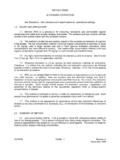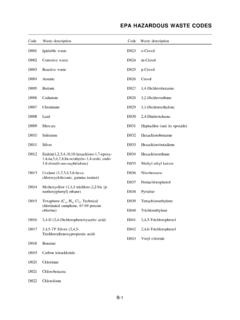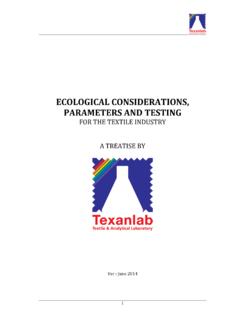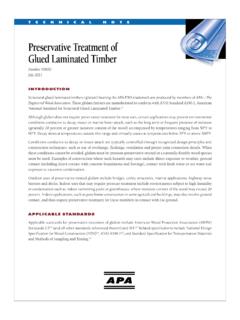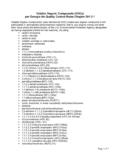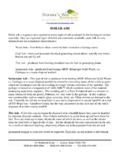Transcription of METHOD 3500B ORGANIC EXTRACTION AND …
1 CD-ROM3500B - 1 Revision 2 December 1996 METHOD 3500 BORGANIC EXTRACTION AND SAMPLE AND 3500 provides general guidance on the selection of methods used in thequantitative EXTRACTION (or dilution) of samples for analysis by one of the semivolatile or nonvolatiledeterminative methods . Cleanup and/or analysis of the resultant extracts are described in ChapterTwo as well as in METHOD 3600 (Cleanup) and METHOD 8000 (Analysis). following table lists the EXTRACTION methods , the matrix and the analyte EXTRACTION methods FOR SEMIVOLATILES AND NONVOLATILESM ethod #MatrixExtraction TypeAnalytes3510 AqueousSeparatory FunnelSemivolatile & NonvolatileLiquid-Liquid ExtractionOrganics3520 AqueousContinuous Liquid-Semivolatile & NonvolatileLiquid ExtractionOrganics3535 AqueousSolid-Phase ExtractionSemivolatile & Nonvolatile(SPE)Organics3540 SolidsSoxhlet ExtractionSemivolatile & NonvolatileOrganics3541 SolidsAutomated SoxhletSemivolatiles & NonvolatileExtractionOrganics3542 Air Sampling TrainSeparatory Funnel &Semivolatile OrganicsSoxhlet Extraction3545 SolidsPressurized FluidSemivolatile & NonvolatileExtraction (ASE) (HeatOrganics& Pressure)
2 3550 SolidsUltrasonic ExtractionSemivolatile & NonvolatileOrganics3560/SolidsSupercriti cal FluidSemivolatile Petroleum3561 EXTRACTION (SFE)Hydrocarbons & PolynuclearAromatic Hydrocarbons3580 Non-aqueous SolventSolvent DilutionSemivolatile & NonvolatileSoluble 3580 may be used for the solvent dilution of non-aqueous semivolatile andnonvolatile ORGANIC samples prior to cleanup and/or - 2 Revision 2 December 3545, 3560, and 3561 are techniques that utilize pressurized solvent extractionto reduce the amount of solvent needed to extract target analytes and reduce the EXTRACTION timewhen compared to more traditional techniques such as Soxhlet to employing this METHOD , analysts are advised to consult the disclaimer statementat the front of the manual and the information in Chapter Two for guidance on the allowed flexibilityin the choice of apparatus, reagents, and supplies.
3 In addition, unless specified in a regulation, theuse of SW-846 methods is not mandatory in response to Federal testing requirements. Theinformation contained in this procedure is provided by EPA as guidance to be used by the analystand the regulated community in making judgments necessary to meet the data quality objectives orneeds for the intended use of the OF sample of a known volume or weight is extracted with solvent or diluted with choices for aqueous samples include liquid-liquid EXTRACTION by separatory funnel or bycontinuous extractor and solid-phase EXTRACTION (SPE). METHOD choices for soil/sediment and solidwaste samples include standard solvent EXTRACTION methods utilizing either Soxhlet, automatedSoxhlet, or ultrasonic EXTRACTION . Solids may also be extracted using pressurized extractiontechniques such as supercritical fluid EXTRACTION or heated pressurized fluid EXTRACTION .
4 Resultant extract is dried and concentrated in a Kuderna-Danish (K-D) concentration devices or techniques may be used in place of the Kuderna-Danish concentratorif the quality control requirements of the determinative methods are met ( METHOD 8000, Sec. ).NOTE:Solvent recovery apparatus is recommended for use in methods that require theuse of Kuderna-Danish evaporative concentrators. EPA recommends theincorporation of this type of reclamation system as a METHOD to implement anemissions reduction Sec. for additional guidance to assist in selection of the appropriate , reagents, glassware, and other sample processing hardware may yield artifactsand/or interferences to sample analysis. All these materials must be demonstrated to be free frominterferences under the conditions of the analysis by analyzing METHOD blanks.
5 Specific selectionof reagents and purification of solvents by distillation in all-glass systems may be necessary. Referto each METHOD for specific guidance on quality control procedures and to Chapter Four for guidanceon the cleaning of coextracted from the samples will vary considerably from source to analysis of an extracted sample is prevented due to interferences, further cleanup of the sampleextract may be necessary. Refer to METHOD 3600 for guidance on cleanup esters contaminate many types of products commonly found in the , in particular, must be avoided because phthalates are commonly used as plasticizers andare easily extracted from plastic materials. Serious phthalate contamination may result at any timeif consistent quality control is not - 3 Revision 2 December residue ( sodium dodecyl sulfate), which results in a basic pH on glasswaresurfaces, may cause degradation of certain analytes.
6 Specifically, Aldrin, Heptachlor, and mostorganophosphorus pesticides will degrade in this situation. This problem is especially pronouncedwith glassware that may be difficult to rinse ( , 500-mL K-D flask). These items should behand-rinsed very carefully to avoid this AND to the specific METHOD of interest for a description of the apparatus and recovery apparatus is recommended for use in methods that require the use ofKuderna-Danish evaporative concentrators. Incorporation of this apparatus may be required byState or local municipality regulations that govern air emissions of volatile organics. EPArecommends the incorporation of this type of reclamation system as a METHOD to implement anemissions reduction program. Solvent recovery is a means to conform with waste minimization andpollution prevention initiatives.
7 To the specific METHOD of interest for a description of the solvents reagent water. All references to water in this METHOD refer to ORGANIC -freereagent water as defined in Chapter standards for spiking solutions - Stock solutions may be prepared from purestandard materials or purchased as certified solutions. The stock solutions used for the calibrationstandards are acceptable (dilutions must be made in a water miscible solvent) except for the qualitycontrol check sample stock concentrate which must be prepared independently to serve as a checkon the accuracy of the calibration stock standard solutions by accurately weighing about g of purecompound. Dissolve the compound in a water miscible solvent ( , methanol, acetone, 2-propanol, etc.) and dilute to volume in a 10-mL volumetric flask.
8 If compound purity is 96percent or greater, the weight can be used without correction to calculate the concentrationof the stock standard solution. Commercially-prepared stock standard solutions can be usedat any concentration if they are certified by the manufacturer or by an independent standard solutions should be stored in polytetrafluoroethylene(PTFE)-sealed containers at 4EC or below. The solutions should be checked frequently forstability. Refer to the determinative METHOD for holding times of the stock standards - A surrogate ( , a compound that is chemically similar to theanalyte group but is not expected to occur in an environmental sample) should be added to eachsample, blank, laboratory control sample (LCS), and matrix spike sample just prior to EXTRACTION orprocessing.
9 The recovery of the surrogate standard is used to monitor for unusual matrix effects,gross sample processing errors, etc. Surrogate recovery is evaluated for acceptance by determiningwhether the measured concentration falls within the acceptance - 4 Revision 2 December surrogates for certain analyte groups are listed in Table 1. Formethods where no recommended surrogates are listed, the lab is free to select compoundsthat fall within the definition provided above. Even compounds that are on the METHOD targetanalyte list may be used as a surrogate as long as historical data are available to ensure theirabsence at a given site. Normally one or more standards are added for each analyte a surrogate spiking concentrate by mixing stock standards preparedabove and diluting with a water miscible solvent.
10 Commercially prepared spiking solutions areacceptable. The concentration for semivolatile/nonvolatile ORGANIC and pesticide analysesshould be such that a 1-mL aliquot into 1000 mL of a sample provides a concentration of 10times the quantitation limit or near the mid-point of the calibration curve. Where volumes ofless than 1000 mL are extracted, adjust the volume of surrogate standard proportionately. Formatrices other than water, 1 mL of surrogate standard is still the normal spiking , if gel permeation chromatography will be used for sample cleanup, 2 mL should beadded to the sample. See Table 1 for recommended surrogates. The spiking volumes arenormally listed in each EXTRACTION METHOD . Where concentrations are not listed in a METHOD ,a concentration of 10 times the quantitation limit is recommended.
